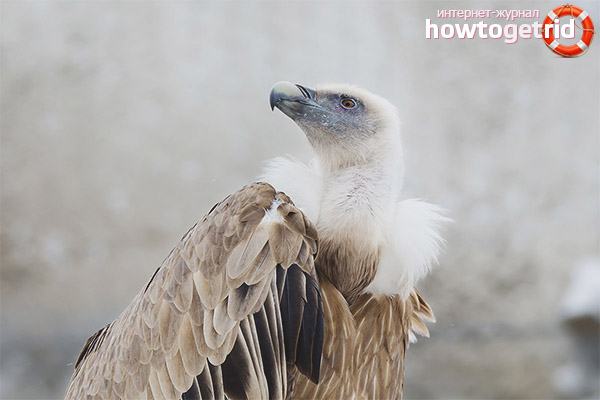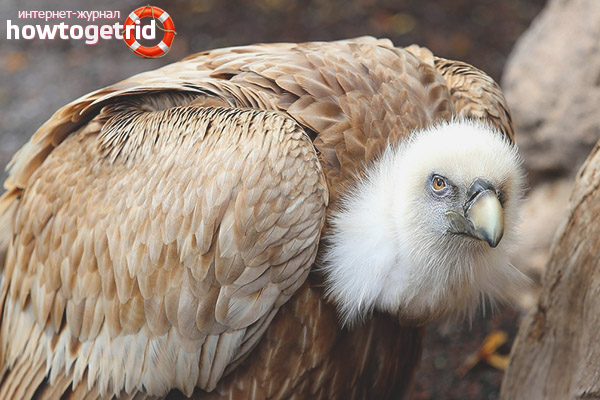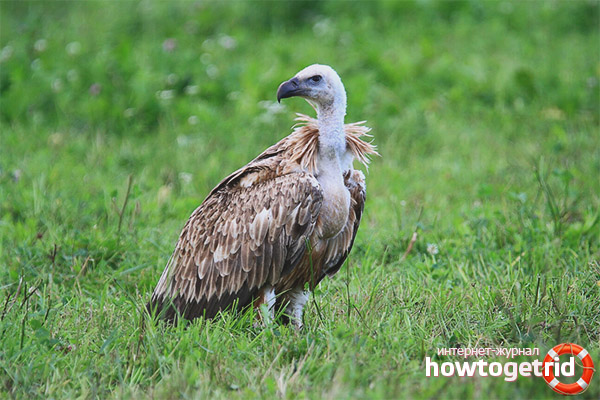The content of the article
The white-headed vulture is a characteristic representative of its species, it belongs to the hawk family, and it consists in a detachment of birds of prey. The body length of this bird reaches 105 centimeters, it has a tail 29 centimeters long, the width of its wingspan can reach 265 centimeters, and the maximum weight of an adult is 10 kilograms.
The vulture possesses the plumage of a characteristic pale yellow color, the feathering of its wings, as well as the tail feathers located in the tail of the bird, are highlighted in a darker shade. The head and the whole long neck of the scavenger are covered with short fluff of bright white color, on the chest, around its neck there is a white plumage ring resembling a fur collar in appearance.
The bird has a large beak, curved in the shape of a hook, used for cutting carcasses. On the ground, the vulture moves on poorly developed legs, the blunt claws of which can serve as a support, allowing you to maintain balance. In the process of feeding, poorly adapted bird claws do not take part.
You can meet the white-headed vulture in the mountainous regions of Asia, in Turkey, and also in the open spaces of northwestern Africa. In addition, the bird lives in France and neighboring Spain, on the islands of the Mediterranean Sea - Sardinia and Crete, as well as Cyprus and Sicily.
Over the past century, the number of white-headed vulture in Europe has declined significantly. In this area, for a large scavenger to get food for himself is not an easy task. In Spain, a program was launched to help birds feed, and carcasses of animals were specially imported to bird nesting areas to provide food for sipes.
Individual characteristics of the bird
The next peculiarity of this species of birds is that the strong sinewy neck of the bird, like its head, does not have the plumage habitual for birds, they are covered with a rather soft cover, consisting of down. Such a characteristic can give the bird additional advantages in cutting carcasses - blood and small pieces of flesh that fall on the bird’s neck or head are well behind the downy surface.
Using the capabilities of his well-honed beak, the griffon vulture with ease ease removes exclusively all the fragments that make up the victim’s muscle tissue. Exceptions are not even ligament nodes formed from durable cores.
Breeding of white-headed vultures
The season for nesting in the white-headed vulture begins in January and continues until April. Before mating, birds perform a characteristic dance characteristic of birds during the mating season. The pair rises into the sky and begins to circle in complete silence, sometimes performing complex acrobatic stunts. The main condition of this dance is the complete synchronization of joint actions, even the wings of birds move like reflections in the mirror.Circular movements are made by partners in a spiral, adhering to the desire to fly higher with each subsequent turn of the spiral. Having gained the necessary height, the birds continue to circle around each other, continuing their dance.
To arrange their nesting, white-headed vultures gather in colonies numbering from 20 to 30 individuals. For the construction of their nests, birds of this species choose impregnable ledges located on the steep slopes of the mountains or impregnable niches, sometimes found in rock formations.
The female vulture lays a clutch consisting of one egg, in rare cases there may be 2. Both individuals take part in hatching the offspring, successively replacing each other, the incubation period lasts from 42 to 50 days.
Sipa chicks are born blind, with a coating consisting only of a skin completely devoid of plumage or fluff. Adults use food found in their stomachs to feed the chicks. To do this, they have to burp semi-digested food fragments and feed them to the chicks as baby food.
The birds begin to make their first attempts to leave the nest when they are 90 days old, and the first flight experience occurs only in the 16th week of the life of young individuals. White-headed vultures reach their maturity only in the fifth year of life.
Characteristic habitats
Representatives of the white-headed vulture form their habitats near mountain ranges or rocks. At high altitude, the birds feel completely safe, here they find everything they need for their rest and the construction of nests. An excellent view opens up from the heights, helping the sipes to monitor the surrounding area in order to detect potential prey. But mountain peaks located at too high a height, with excessively cold and humid conditions, are not attracted to white-headed vultures.
Representatives of this species of birds try to stay at a distance from a person, avoiding direct contact with him. Although they often locate their nesting sites near various villages, it is easier for them to find their prey among fallen domestic animals, which often die or need to be destroyed, as a result of various epidemics that are not rare these days.
Griffon vultures spend the night time on the tops of the cliffs, which they have chosen, forming flocks consisting of 30-40 individuals. They are not in a hurry to leave their places of spending the night, for this they need to wait until the morning sun warms up the earth well, creating air streams ascending to the sky, facilitating the flight conditions for the birds.
Toward evening, when the sun is setting, the vultures have to return to the place of spending the night. Here the daily ceremony is performed, when the birds make a flight around the overnight territory at the beginning, and after that they take turns sitting down, each in its place.
Nature endowed representatives of birds of this species with extraordinary sensitivity to the movement of air masses. They very clearly capture the warm streams of air rising from heated surfaces, and are able to soar for many hours in the sky without wasting their energy.
Diet for large poultry
The white-headed vulture is considered a bird of prey, although its main diet is carrion. Only in exceptional cases does he get fresh meat when he is left to attack small animals or to finish off an exhausted victim. But he prefers vulture to peel the corpses of various ungulates, which he skillfully cuts using his well-adapted beak.
In flight, the white-headed vulture keeps warm air currents emanating from the heated soil. Keeping in their stream with the help of huge wings, the bird moves in a spiral, gradually rising up. Despite the fact that they scatter in different directions, they do not lose visual contact between each other. This technique allows them to patrol vast territories.
When someone from the flock was lucky to discover the prey, he goes down, and the rest of the individuals, seeing his maneuver, rush to join the feast. In a pack of sipes there is a certain hierarchy. The leader of the pack starts the meal first, he slowly, rips open the skin of the dead animal and plunges his head into the inside of the carcass. Only after this can the remaining birds join in, waiting for the end of the obligatory ritual.
Video: griffon vulture (Gyps fulvus)












Submit